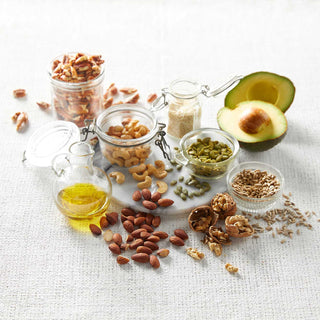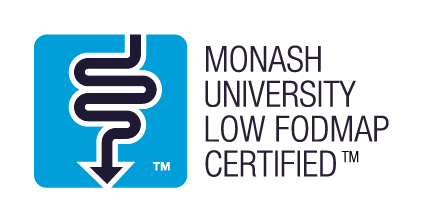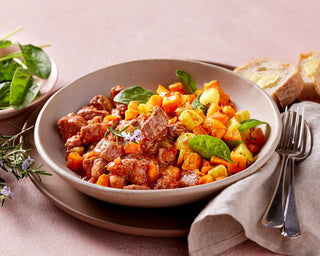
We’ve all heard of the mantra eat more ‘good fats’ and less ‘bad fats’ but what classifies a fat as ‘good’ or ‘bad’, how do we tell them apart and where do all of them live? Our good fat guide takes the mystery out of fat so you know what to eat more of and what to minimize is you diet. You’ll be a fat expert before you know it!
Fa(c)t Check:
Fats can include phospholipids, phytosterols, cholesterol and triglycerides. Triglycerides are the main types of fat found in the diet and are made up of one glycerol plus three fatty acids to serve two purposes, one, for energy use and two, for storage.
Fats also increases the absorption of vitamins and minerals, builds cell membranes and also plays a role in blood clotting, muscle movement and inflammation. When it comes to food, it enhances the texture, flavour and aroma to bring you a ‘feel good’ mouth feel and let’s be honest, rich, creamy deliciousness.
Fatty acids are classified as either saturated, monounsaturated or polyunsaturated depending on their chemical composition. Those that are saturated are usually derived from animal-based products and those that are monounsaturated and polyunsaturated are usually plant-based (NHMRC).
20-30% of an individual’s daily energy is recommended to come from fat, with no more than 10% from saturated fat! So, let’s break these down & look at them in more detail.
Unsaturated Fats - Healthy!
Liquid at room temperature and therefore technically an ‘oil’, unsaturated fats are considered ‘healthy’ fats due to their role in reducing the risk of heart disease and lowering cholesterol levels (NHMRC). There are two main types: polyunsaturated and monounsaturated.
Polyunsaturated Fats
Polyunsaturated fats can lower “bad” low-density lipoprotein (LDL) cholesterol and increase the “good” high-density lipoprotein (HDL) cholesterol, which is necessary for better heart health. This was made evident when a 2016 study came out analysing more than 46,000 participants and found that those with higher concentrations of omega-3 were 10% less likely to die from a heart attack compared to those with lower volumes. In addition to this, omega – 3 fatty acids are also vital for eye health, display anti-inflammatory properties and are known as ‘beauty enhancers’ as low dietary intakes are related to rough, scaly skin and dermatitis. In other words, eat them to get your glow on.
They are considered ‘essential’ fats because they can’t be made in the body and must be eaten.
Food rich in polyunsaturated fats:
- Omega -3 fats: oily fish like salmon, sardines, trout & barramundi, tahini, linseed, chia seeds
- Omega- 6 fats: safflower and soybean oil, brazil nuts, pine nuts, walnuts
-
Dineamic Suggestions: Soy and Ginger Salmon with Hokkien Noodles & Steamed Vegetables.
Monounsaturated Fats:
Monounsaturated fats contain one “double bond” (hence, the “mono” in their name). A common source includes ‘oleic acid’ which is found in olive oil, canola oil, and almond, macadamia & peanut oils. They are considered ‘healthy fats’ because they maintain ‘good’ cholesterol and reduce ‘bad’ cholesterol again for better heart health. Despite not being as effective as polyunsaturated fats, monounsaturated fats are considered more stable and do not ‘go off’ (oxidize) as easily making them a great alternative for manufacturers and researchers. They are also abundant in the Mediterranean diet, which we all know and love and has been linked to lower heart disease.
Food rich in monounsaturated fats:
- Avocadoes (yasss! Good & good for you!)
- Nuts (e.g. cashews, almonds, pistachios, hazelnuts, pecans)
- Lean meats
- Eggs
- Fish
- Extra Virgin Olive Oil! Did you know we use olive oil in our meals?
Saturated Fats - Less Healthy!
Solid at room temperature, saturated fats contain no ‘double bonds’ and come mostly from animal sources. Reducing saturated fats is often recommended by public health bodies as consuming large amounts have been linked to higher total blood cholesterol levels and increased LDL cholesterol. Recent data has also shown that the compensatory effects of reducing saturated fats are also important to consider when uncovering the health effects. For example, reducing saturated fat and replacing it with unsaturated fats and wholegrain reduces the risk of heart disease but if you replace them with refined carbohydrates, the risk of cardiovascular disease increases1.
Foods that contain saturated fat:
- Meats (beef, pork, lamb and chicken, processed meats)
- Coconut oil, coconut milk and cream
- Biscuits, cakes and pastries
- Potato chips, deep-fried foods, takeaway meals (e.g. pizza).
Trans fats - Unhealthy!
Trans fats can be found naturally in some animal products or produced during manufacturing. The manufactured kinds are formed when vegetable oils are ‘hardened’ to create spreads such as margarine and shortening or occasionally during high temperature cooking (FSANZ). Trans fats have been known to increase the amount of ‘bad’ cholesterol and decrease the amount of ‘good’ cholesterol making them a no-no when it comes to choosing fats.
Interestingly, labelling of trans fats is not mandatory, fortunately however the margarine available in Australia contain the lowest in the world at 0.2g trans fat per 100g versus 4g per 100g found in butter.
Want to learn how to decode food labels? Check out our post HERE
Foods that contain trans fat:
- Processed cakes, biscuits, pastries,
- Pie crusts
- Crackers with shortening
- Potato chips
- Fried foods
Tips to reducing saturated and trans fat in your diet:
- Include meatless days, not only will you increase your vegetable untake but you'll also decrease your saturated fat intake.
- Choose Extra Virgin Olive Oil over other oils.
- ‘Hydrogenated oils’ or ‘partially hydrogenated vegetable oils’ are interchangeable names for trans fats, be on the lookout when reading through a label
- Because omega-6 can be found in many oils, this sometimes means that discretionary items can also ‘contain omega-6’ but don’t be fooled they’re still only ‘sometimes’ foods.
- Eat less takeaway meals! If you’re keen for something like takeaway, check out our Thai, Mexican or Italian options and choose Dineamic instead.
Bottom Line:
Don't be afriad of fat! Although it is important to follow the recommendations of the Australian Dietary Guidelines, DAA and The Heart Foundation in limiting certain amounts of fat and replacing them with the good kind, we must remember not get too bogged into one nutrient. After all it is the combination of foods rather than one nutrient that’s most important. Go for balance in your diet & incorporate all food groups. And remember, if you’re eating healthy most of the time, then don’t be afraid to have the occasional cheeky treat.
Reference:
- Clifton P and Keogh K. Dietary fats and cardiovascular disease: an Evidence Check rapid review brokered by the Sax Institute (www.saxinstitute.org.au) for the National Heart Foundation of Australia 2017.









